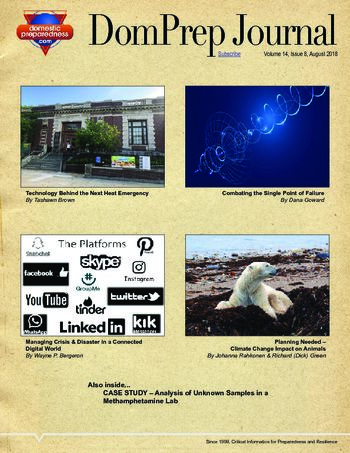

Disasters – Seeing the Big Picture
Catherine L. Feinman
August 29, 2018
Stakeholders in each discipline are tasked with protecting their industries’ assets and resources
from potential risks and threats. However, each industry is interdependent on numerous other industries
and their preparedness practices. The “whole community” concept encompasses the “all for one and one for
all” motto. Together, communities can build strength and resilience. Apart, they may miss the warning
signs and opportunities to mitigate disaster.

Combating the Single Point of Failure
Dana A. Goward
August 22, 2018
On 25-26 January 2016, many first responder radio systems across North America reported faults. The U.S. government received similar reports from cellular networks and digital broadcast companies around the world. A Federal Aviation Administration (FAA) flight safety system called ADS-B was also out of service for several hours. Some systems failed, some services were degraded, others just alarmed. All required human intervention and caused concern for the better part of a day.

CASE STUDY: Analysis of Unknown Samples in a Methamphetamine Lab
Sponsored Case Study
August 22, 2018
A clandestine drug lab is a health and safety nightmare for first responders. The chemicals are
almost never labelled. The initial on-site team is normally followed by several hazardous materials
technicians. These experts need to make sure the crime scene is safe and dangerous items are properly
handled before evidence technicians can fully process the scene.

Technology Behind the Next Heat Emergency
Tashawn Brown
August 15, 2018
According to the National Weather Service, there were 107 fatalities across the United States related to heat in 2017 – more than the deaths related to tornados, hurricanes, and cold weather combined.

Managing Crisis & Disaster in a Connected Digital World
Wayne Bergeron
August 8, 2018
#SafetyBeforeSelfie – Please make sure to exit the burning building before texting, tweeting, posting, or live streaming about it. Surprisingly, the current security and emergency management (EM) environment that exists

Planning Needed – Climate Change Impact on Animals
Johanna Rahkonen and Richard Green
August 1, 2018
Animal populations will be uniquely impacted by the increasing, changing, and compounding disasters attributed to the rapidly advancing effects of climate change. Companion animals will face displacement, livestock will suffer from physiological stressors, and wildlife may face localized extinctions. Animals from all sectors may experience increased instances of negative health outcomes such as infectious diseases. Emergency and disaster planners must take steps to proactively assess the impact of climate changes on animals within their communities as they work to improve their climate resilience.

